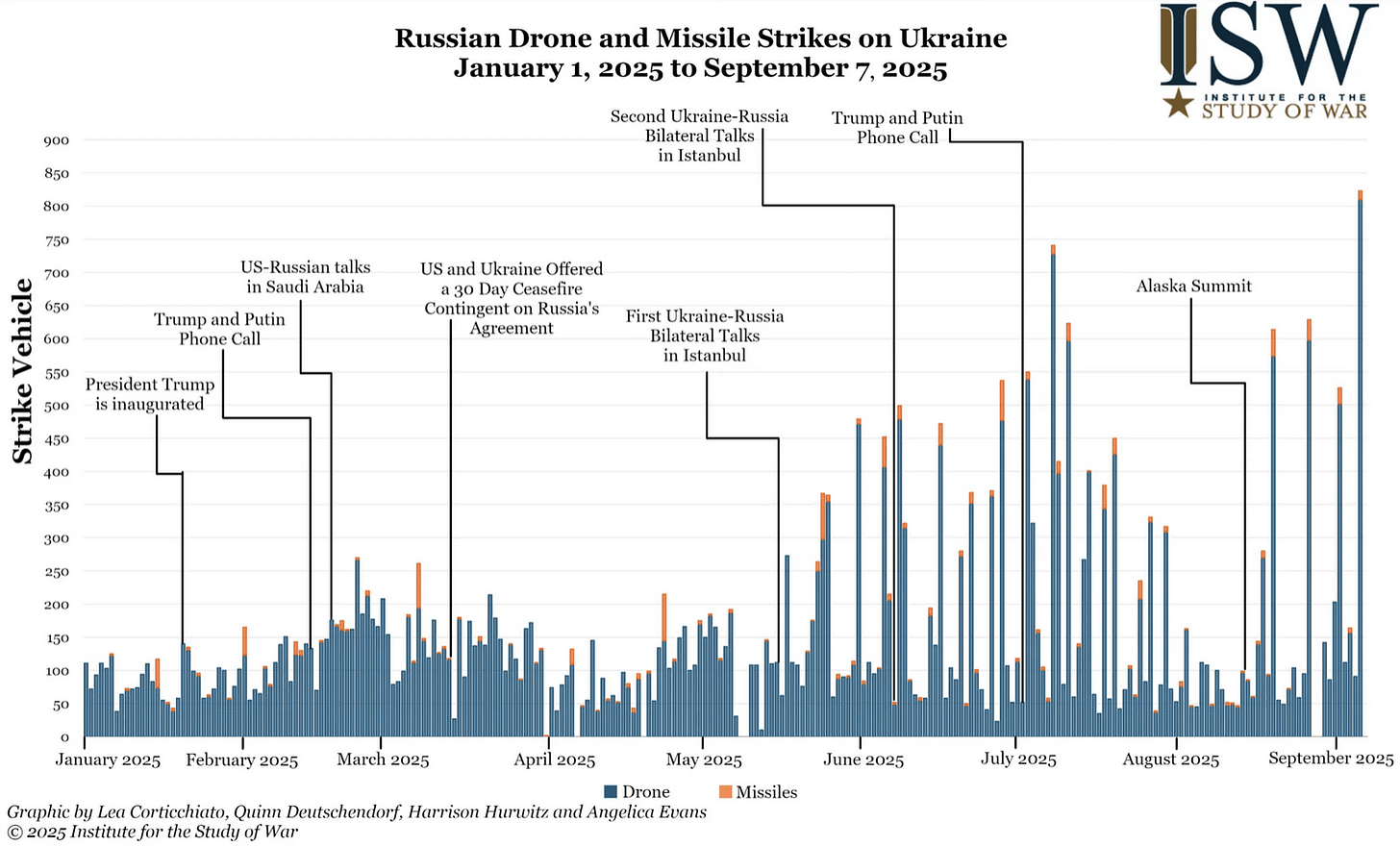Issue Brief - Demystifying the Myth of Russian Inevitability
An in-depth look at geopolitical and economic trends
By: Fritz Lodge
Welcome back to the TSG Issue Brief, where we take an in-depth look at geopolitical and economic trends. In this Issue Brief, Fritz Lodge explains why the persistent myth of the inevitability of Russian military success is false and how Russian efforts to push this narrative may signal weakness, not strength.
This article originally appeared in Policy Magazine on September 19.
More than a month after the Donald Trump-Vladimir Putin summit in Alaska, the path to a negotiated settlement of the war in Ukraine appears more distant than ever.
Russia continues its current offensive against Ukrainian targets (recently launching several of the largest aerial attacks of the war). Its unprecedented drone incursion into Poland September 9-10 (since followed by violations of Romanian and Estonian airspace) led Warsaw to invoke NATO’s Article 4 for allied consultation.
President Trump, for his part, has returned to expressions of frustration with Putin’s intransigence and threatening new sanctions (although these must be taken with a grain of salt after multiple reversals).
In truth, there was little reason to expect real progress in US-mediated negotiations following the Alaska summit. President Putin had signaled — and continues to signal — no compromise in his core war objectives, which extend well past territorial aims to include Ukraine’s demilitarization (neutering its ability to resist future attack), “denazification” (effectively the replacement of its government with pro-Russian proxies), and an injunction against NATO membership, or indeed the presence of any Western forces in Ukraine.
Several of these goals are non-starters for Ukraine and Europe (and likely the US as well), so why was there any expectation of progress?
There are a number of explanations for this disconnect — including Trump’s oft-repeated desire for a swift end to the war and Special Envoy Steve Witkoff’s apparent misinterpretation of meetings with Putin — but one that has gone relatively unremarked is the recent emergence of a distinct narrative that presents a sense of inevitable Russian victory. In this narrative, Russia’s advance is grinding but unstoppable over time and Ukraine must eventually accede to Russia in the face of that fait accompli.
That narrative is likely wrong. Of course, the severe challenges Ukraine faces should not be diminished. Most notably, it has struggled with recruitment and understrength based on serious manpower shortages.
Most tragically, Ukraine’s civilian death toll is at least 13,883 and continues rising as Russia intensifies an unrestrained campaign of aerial strikes on civilian targets. However, none of this means that Russia is winning the war; several factors undermine the myth of Russian strength:
Contrary to the often-breathless reporting around relatively marginal advances, Russia’s so-called “summer offensive” against Ukraine has made very little progress. Indeed, Ukraine recently recovered some territory from Russia’s summer advances. The UK Ministry of Defence estimates it would take Russia 4.4 years and nearly 2 million more casualties to conquer the rest of the four Oblasts in Ukraine that it claims. The offensive is likely to continue into the fall, but colder weather could increasingly favor Ukraine on the defensive (e.g., Russian forces will lose leaf cover to hide their small-unit infiltration advances from Ukrainian drones).
Russia has advantages in manpower, equipment, and munitions, but its losses are staggering – e.g., nearly 1 million casualties, over 4,000 vehicles, nearly 2,000 tanks. Its manpower advantage may also be finite as voluntary recruitment slows down and Moscow is increasingly forced to turn to North Korea and Central Asia for soldiers. Putin is wary of the political consequences of forced conscription, especially in the more populated regions between Moscow and St. Petersburg.
Ukrainian long-range strikes have become increasingly effective (and may become more so if the Trump administration decides to remove range limitations on US weaponry). Strikes on Russian gas infrastructure, in particular, are bringing the war home to Russian civilians with price hikes and fuel shortages; these shortages forced Russia to temporarily ban fuel exports.
The Russian economy is not collapsing, but it is increasingly strained. GDP growth hovers at 1% this year and may drop to 0%, high inflation from wartime spending has forced the Bank of Russia to push interest rates above 18%. Lower oil prices and European sanctions targeting Russia’s shadow fleet are also depleting oil revenues. A new EU sanctions package unveiled September 19 caters to Trump’s demands for sanctions against China over its Russian oil imports (it is unclear if Trump himself will follow through on new sanctions).
So where does the myth of Russian inevitability come from? In Washington, this is an argument mostly made in good faith and out of concern over the devastating toll the war is inflicting on Ukraine.
But its emergence ahead of and through the Alaska summit attests to a significant propaganda effort emanating from Moscow that seeks to shape Western perspectives towards a belief that Ukraine’s situation is ultimately hopeless.
The good news? Far from demonstrating faith in victory, this propaganda effort may in fact demonstrate the Kremlin is increasingly concerned about its ability to sustain the war in the long term. Putin may hope to achieve via disinformation and negotiations what he cannot achieve on the battlefield.
Denying him that option and continuing to bring the costs of war to Russia is the fastest — and perhaps only — way to peace, forcing Putin to reconsider his maximalist demands and approach negotiations realistically.
This article was originally published in Policy magazine. To view the original article, click here.

